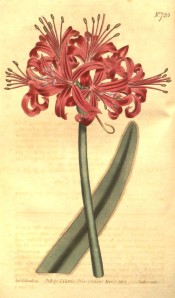Nerine curvifolia (Jacq.) Herb.
Nerine curvifolia is now considered synonymous with Nerine sarniensis Herb., although it was considered a distinct species through most of the 19th century. A separate entry is given here for completeness. Like Nerine sarniensis, Nerine curvifolia was listed in all the published catalogues suggesting that Macarthur considered them to be sufficiently distinct.
Bulbous perennial, the stems to 60cm, bear umbels of up to 15 scarlet flowers with strongly recurved, somewhat spiralling petals in autumn, the up to 8, strap-like leaves usually appearing after the flowers. [RHSD, Hortus, Baker Am.].
Horticultural & Botanical History
First described as Amaryllis curvifolia by Jacquin in 1797 [Jacquin Sch. vol.1, p.33/1797]. Transferred to Nerine under this specific name by Herbert in 1820 [BM t.2124/1820].
‘[Amaryllis curvifolia] Spathe as usual in the genus, containing a many-flowered convex umbel of bright glittering scarlet flowers, without scent. […] Blooms at various seasons; is generally treated as a stove plant; though we should think it would do better at the foot of a southern wall with belladonna, but not planted too shallow. According to the Banksian Herbarium, our plant was brought into the Kew Gardens about 1788, from the Cape; Jacquin received it from the same place. There is a gardening tradition that it was likewise received from Japan by the late Dr. Fothergill; if so, this, with belladonna and sarniensis, would make the third species of the genus that is common to the Cape as well as to countries immensely distant from it; but we confess that we place no reliance whatever on the story beyond its bare possibility. Our drawing was taken at Messrs. Grimwood and Wykes’s, Kensington.’ [BM t.725/1804]. Dr. Fothergill’s plant was most likely a Lycoris species, probably Lycoris radiata which was reportedly introduced from China by Fothergill. The reference to belladonna being found distant to the Cape is a reference to Linnaeus applying the name Amaryllis belladonna to species of Hippeastrum.
Amaryllis fothergillii is figured in Andrews' Botanical Repository: ‘The flowers have the same vivid character of refulgence, when exposed to the sun’s rays, which is perceived in Amaryllis Sarniensis, to which it is nigh affined.’ It was introduced in 1777. [ABR pl.163/1801].
History at Camden Park
Listed in all published catalogues [B.354/1843].
Notes
Published May 25, 2009 - 04:32 PM | Last updated Aug 09, 2012 - 02:32 PM
| Family | Amaryllidaceae |
|---|---|
| Category | |
| Region of origin | South Africa |
| Synonyms | For synonymy see Nerine sarniensis Herb.
|
| Common Name | |
| Name in the Camden Park Record | Nerine curvifolia
|
| Confidence level | high |


